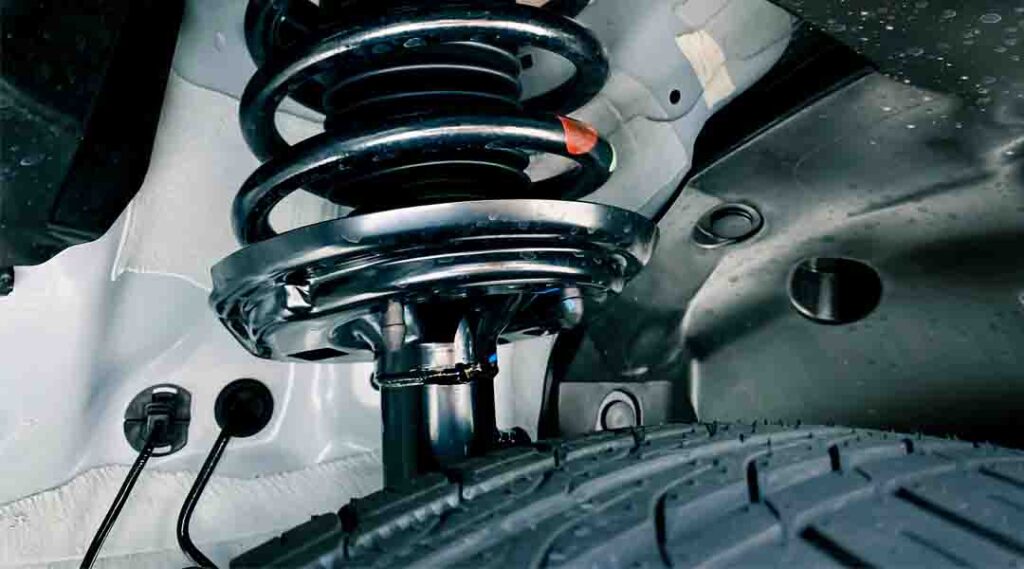This post was originally published on www.progressive.com
Your car’s shocks and struts are responsible for keeping the vehicle’s body suspended above the wheels and comfortably off the ground while driving. Without them, you’d bounce along the road, making for an uncomfortable and unsafe ride. Shocks and struts convert the up-and-down movement of the car into energy, which they absorb every time you hit a pothole or a bump in the road. When they wear down, you lose control of the car’s stability, and the car takes longer to stop. “Shocks and struts are safety-related as much as they are comfort-related,” says Marshall Castle, an ASE-certified master automotive technician and owner of Chicago Car Care, Inc.
Shocks vs. struts: What’s the difference?
While shocks and struts are both parts of your car’s suspension system, they are fundamentally different components. Shock absorbers are located behind the tires and work alongside a separately mounted spring. The sole job of car shock absorbers is to stop the car from bouncing.
Car struts combine a shock and spring assembly in one unit that is part of the structural make-up of the vehicle. These heavy-duty, weight-bearing components are attached to the wheel. In addition to softening the ride, struts also hold the tire in position and provide valuable support to the vehicle’s braking and steering systems.
“Depending on the suspension, some cars feature a combination of both shocks and struts,” Castle says.
How do you know when to replace shocks and struts?
According to Castle, most customers with shock or strut issues complain of a knocking or rattling noise when they drive over a bump. Or if the mounting parts are worn down, other bad strut symptoms include a loud, creaking sound. If the shocks or struts are in terrible shape, the car will bottom out every time it hits a bump or rough patch in the road.
More than anything, worn shocks and struts typically influence the car’s overall feel while driving. Most people don’t recognize the telltale signs because the deterioration is slow over time. “The way the car drives feels normal because they’ve been driving it every day,” Castle says. “That’s why routine car safety inspections are so important. Your mechanic can catch subtle things before they become bigger problems.”
Front strut replacement
Driving too long on worn shocks and struts can negatively impact the car’s performance and become a safety issue. For example, without proper support from the suspension system, the front end will pitch forward every time you stop. Bad shocks and struts also affect how the car corners a turn. If the car is unstable through a turn, you might crank the steering wheel to compensate and suddenly lose control.
“When the car doesn’t respond the way you expect it to, that’s when things get dangerous,” Castle says.
Beyond safety concerns, falling parts from failed shocks and struts can jam up your steering system or blow out your tire because of their location next to the wheel. Suddenly you’re not only replacing one component but replacing or repairing several.
How to maintain your shocks and struts
Like most core components, your car’s shocks and struts are designed to withstand normal wear and tear, including the occasional pothole.
Practicing good driving habits can help extend their life. Slow down when you approach speed bumps. Reduce speed when turning corners to reduce the strain on your vehicle’s suspension. And, most importantly, have your car checked out when you get an oil change. In some cases, your mechanic can lubricate the suspension points around the shocks and struts to give them new life.
How long do shocks last?
Most manufacturers recommend replacing the suspension, which includes the shocks and struts, every 50,000 miles. Typically, your mechanic will also suggest a tire alignment because the steering and suspension systems work closely together. But if you put your car through the wringer, your shocks and struts can fail more quickly. If you drive carefully and avoid curbs and potholes, your shocks, struts, and suspension system can last between 50,000 and 100,000 miles.
[ad_1]
